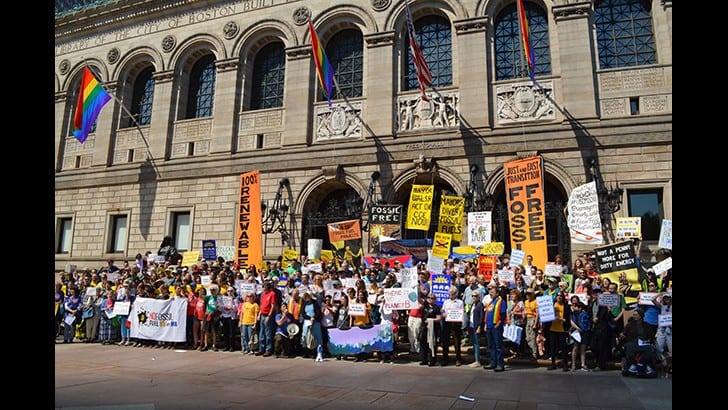
An East Cambridge courthouse update
It’s sad when a local public official claims powerlessness before real estate developers, the market, and state government. But that’s exactly what Cambridge Mayor Marc McGovern is doing in the latest round of the already half-century long East Cambridge Courthouse saga. Which I wrote about in some detail in my May 22 column, “Cambridge Councilors Can Stop Undemocratic Courthouse Deal.” To understand why I think that McGovern is abrogating his responsibility to defend the public interest in the battle over the future of the property in question, a (necessarily dense) brief review is in order.
Background
The 22-story East Cambridge Courthouse was built by Middlesex County government starting in the late 1960s and finished—despite strong protests from the neighborhood—in 1974. It was far taller than the surrounding area, ugly, indifferently constructed, and filled with asbestos. The county government went bankrupt and state government inherited the structure in 1997. The state moved the courthouse staff to Woburn in 2008, and the unfortunate denizens of the prison on top of the building to other area prisons by 2014.
Meanwhile, the state offered the building to the city of Cambridge. But the city manager of the time rejected that deal while the City Council stood down—despite community support for the city taking over the building, remediating the asbestos, levelling it, and developing much-needed public housing and other public improvements on the site—leaving the state to put out two poorly run calls for bids from commercial developers to buy the property. In December 2012, the state announced that Leggat McCall Properties (LMP) had the winning bid. And that developer signed a $33 million purchase and sale agreement with the state for the property in January 2013.
Thus began a years-long fight between shifting coalitions of neighborhood activists, politicians, and LMP that supported either a city takeover of the site or allowing the developer to convert the courthouse to a commercial office tower. Over time, even as court challenges by pro-public-use activists failed, LMP was pushed to provide some improvements to its original vision—including taking two floors off the top of the tower, adding 24 low-to-moderate-income apartments, and providing some community space. To date it has paid about $5 million dollars in various costs associated with acquiring the courthouse property, but has not completed its purchase.
Last fall, Cambridge (and Somerville) State Representative Mike Connolly—agreeing with the neighborhood activists that supported a public vision for the site—started a process that resulted in the 2019 release of a “Community-Driven Framework.” Which involved the city stopping the state’s sale of the courthouse to LMP by refusing to offer to lease the 420 parking spaces in a nearby city-owned lot required to complete the deal under the terms of the (hotly contested) Cambridge Planning Board Special Permit, buying the building, remediating the asbestos, tearing it down, and then seeking a combination of city, state, and federal money to build public housing, parks and other improvements of use to the community.
The renewed debate over the future of the courthouse site has resulted in three factions: people who support letting LMP complete the purchase of the property and develop the site on a commercial basis, people who prefer the public vision for the site but are sick of fighting about it, and people who stand behind the public vision represented by the Community-Driven Framework. A framework that—contrary to its critics’ attacks—will accept a role for commercial development on the site, as long as community needs for public housing and other amenities are met.
The latter two camps appear to represent the majority of the neighborhood between them; so the smaller pro-LMP camp is striving mightily to win over the fence-sitters who are sick of the whole fight, and stop the City Council from blocking the lease of the contested 420 parking spaces to LMP. Which is what will happen if four out of nine city councilors vote against the lease. Three councilors are now on record against it: Dennis Carlone, Vice Mayor Jan Devereux, and Quinton Zondervan.
So, the future of the courthouse site hinges on a single councilor. In a vote that has now been delayed until September… after pro-public-use neighborhood activists in the East Cambridge Planning Team community group sent a detailed letter to the city about problems with its recent public process in support of leasing the parking spaces to LMP. Specifically, according to the Cambridge Day, “calling the parking study done by city staff to help guide Planning Board members and city councillors ‘fatally flawed,’” “pointing to spaces identified as available to the public when they are not and spaces they say are counted twice,” indicating “that data identified as being gathered on weekdays were actually gathered on Saturdays,” saying that “there is already a waiting list for use of the parking garage that would see 420 parking spaces subtracted and given to drivers at the redeveloped courthouse,” and perhaps most damningly stating “that the city’s disposition law calls for analysis of alternatives to leasing the parking spaces and retail, but the report lacks them. … [T]he law also calls for explanation of ‘any actual or projected annual revenues or costs’ for the property.” No such analysis or explanation of revenues and costs has been presented to the council or the Cambridge public to date.
The Mayor
Marc McGovern is an archetypal neoliberal municipal politician. That he has taken donations from real estate developers and contractors and their relatives goes without saying—since the real estate industry dominates local politics nationwide—but he clearly believes that the way to run a city in 21st-century America is to attract as much big development as possible, get whatever funds collected from the generally small and inoffensive taxes and fees that developers will accept, and then use that money to keep the city attractive enough to hold onto to the developments that are here and entice more developers to build here. While, secondarily, providing public services to residents that are somewhat better than the services cities without big developments have.
Now he has another prominent local politician, Connolly, on his left calling that model of capitalist governance into question. He doesn’t want to lose the LMP deal and doesn’t want to be forced to help figure out ways to fund the Community-Driven Framework for the courthouse site, so he’s taken to attacking Connolly directly.
First in a Cambridge Chronicle op-ed two weeks ago, and Friday in a Facebook post. The fact of the attack is not particularly surprising. But its shape is. Because in both the op-ed and the Facebook post, McGovern is saying that the mayor of one of the richest cities in America per capita—and the elected city council—can do nothing to stop the LMP deal. Due to the supposedly o’erweening power of the city manager, and the edicts of the Commonwealth’s Division of Capital Asset Management and Maintenance (DCAMM)—the agency that controls the courthouse site.
However, City Manager Louis DePasquale is an appointed staffer who serves at the sufferance of the elected city council. So it’s odd to state, as McGovern did in the Chronicle op-ed, that “The city manager has indicated that he will NOT ask for an allocation to bid on this property should it become available.” As if the council’s opinion is moot once the city manager weighs in. Resulting in the spectacle of a sitting mayor—who due to the city’s unusual “Plan E” style of governance is a city councilor elected to be a first among equals by his peers—trying to win a political debate by pretending a staff member the council can fire is able to overrule it on key policy matters.
Then in the Facebook post, McGovern waves around a July 23 letter from DCAMM Commissioner Carol Gladstone to the city manager—stating that it puts “to bed the idea that the State is going to give the court house to the City.” The relevant section of the letter he cites is, “A question has arisen regarding whether the Commonwealth would transfer the property to the City of Cambridge for nominal consideration. The Commonwealth has no plans to do so, due to the pending purchase and sale agreement with Leggat McCall. As required by Chapter 34 of the Acts of 2008, the enabling legislation for this transaction, the Commonwealth expects to obtain full and fair market value for the property.”
But the DCAMM letter puts nothing to bed. It merely restates what is already known in bureaucratese: that DCAMM has no plans to change what it is currently doing. Because the city of Cambridge has not yet exercised its power to stop the LMP deal. Should it do so, the state agency would be forced to go to the table with the city and work out a new plan. Which is the main point of the Community-Driven Framework.
In the service of this line of argument, McGovern has latched onto the current talking points of LMP and its supporters: a) that the building is too much of a health and safety hazard to be allowed to stand long enough to reject the parking spaces, kill the LMP deal, and negotiate a new deal with the state; and b) that the “significant community benefits package” offered by LMP is just awesome, so why would the city want anything more.
To the first point, the health and safety gambit is refuted in a blog comment on an agenda item for this week’s special summer city council meeting by Vice Mayor Jan Devereux: “#7 Report on Condition of the Sullivan Courthouse: As the City Manager’s report states, the building is under close watch 24/7 by two security guards (at the state’s expense) and all the systems and utilities have been shut off. There is no elevated risk of fire in this steel-construction concrete building; asbestos does one thing well, it makes buildings more fire resistant. The Sullivan Courthouse is ugly and too tall and should be demolished, but it is not the imminent public safety threat that some supporters of the developer’s plan have led nervous neighbors to believe.”
To the second point, the cornerstone of the LMP community benefits package is “$23.5 million toward affordable housing.” Sounds great, right? It’s not. It’s peanuts. That figure includes the paltry 24 apartments that neighborhood activists negotiated. In a city where 6,000 people flooded the affordable housing waitlist in 2016 alone, according to the Chronicle. The Community-Driven Framework approach, by way of comparison, could result in many more desperately needed public housing units being built. But that doesn’t seem to matter to McGovern and other LMP allies—who have never demonstrated that $23.5 million is even close to enough affordable housing money to make up for the displacement of more working- and middle-class East Cambridge residents by a fresh wave of highly paid corporate employees in the commercial office space to be built in the courthouse should LMP’s plan go forward. In addition to the displacement being caused by several other major commercial developments underway in and around the neighborhood. Let alone help the city grapple with its accelerating housing crisis. So, LMP would have to pony up a lot more of the huge profits it will doubtless make if the current deal stands before anyone—the mayor of Cambridge least of all—can have the temerity to claim that the developer would be doing right by the so-called “People’s Republic.”
To conclude, I’ll be writing more about the courthouse struggle as the council vote on the parking spaces approaches, but in the meantime I recommend that Cambridge residents—especially those supporters of the public vision for the site represented by the Community-Driven Framework who are tired of fighting—should take anything that Mayor Marc McGovern says about the matter with a 22-story-sized grain of salt.
Apparent Horizon—recipient of 2018 and 2019 Association of Alternative Newsmedia Political Column Awards—is syndicated by the Boston Institute for Nonprofit Journalism. Jason Pramas is BINJ’s executive director, and executive editor and associate publisher of DigBoston. Copyright 2019 Jason Pramas. Licensed for use by the Boston Institute for Nonprofit Journalism and media outlets in its network.



